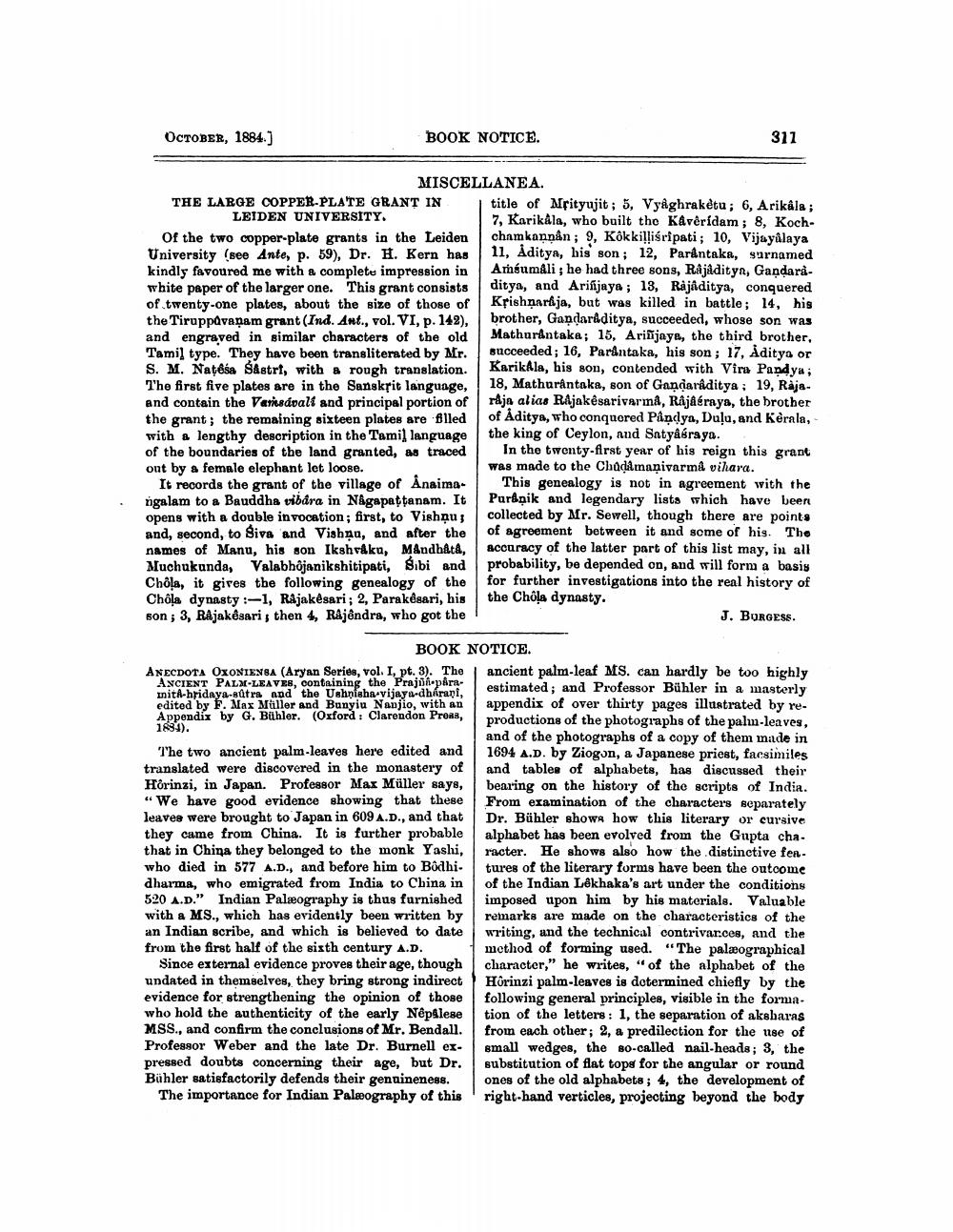________________
OCTOBER, 1884.)
BOOK NOTICE.
311
MISCELLANEA. THE LARGE COPPER-PLATE GRANT IN title of Mrityujit; 5, Vyênghraketu; 6, Arikâla; LEIDEN UNIVERSITY.
7, Karikala, who built the Kåverídam; 8, KochOf the two copper-plate grants in the Leiden chamkannån; 9, Kokkillisripati; 10, Vijayalaya University (see Ante, p. 59), Dr. H. Kern has 11, Aditya, his son ; 12, Parantaka, surnamed kindly favoured me with a complete impression in Amsumali ; he had three sons, Rajådityn, Gandardwhite paper of the larger one. This grant consists ditya, and Ariñjaya; 13, Ràjaditya, conquered of twenty-one plates, about the size of those of Krishnarfja, but was killed in battle; 14, his the Tiruppavanam grant (Ind. Ant., vol. VI, p. 142), brother, Gandaraditya, succeeded, whose son was and engraved in similar characters of the old Mathurantaka; 15, Ariñjaye, the third brother, Tamil type. They have been transliterated by Mr. succeeded; 16, Parantaka, his son ; 17, Aditya or S. M. Naţéśa Såstrt, with a rough translation. Karikala, his son, contended with Vira Pandya; The first five plates are in the Sanskrit language,
18, Mathurantaka, son of Gandaraditya : 19, Raja. and contain the Varsávali and principal portion of rája alias Rajakesarivarma, Rajâéraya, the brother the grant; the remaining sixteen plates are flled of Aditya, who conquered Pandya, Daļu, and Kerala, with a lengthy description in the Tamil language the king of Ceylon, and Satyasraya. of the boundaries of the land granted, as traced In the twenty-first year of his reign this grant out by a female elephant let loose.
was made to the Chudamaņivarma vihara. It records the grant of the village of Anaima. This genealogy is not in agreement with the ngalam to a Bauddha vibára in Nagapattanam. It Par nik and legendary lists which have been opens with a double in vocation; first, to Vishnu collected by Mr. Sewell, though there are points and, second, to Siva and Vishnu, and after the of agreement between it and some of his. The names of Manu, his son Ikshvaku, MAndhAtå, accuracy of the latter part of this list may, in all Muchukunda, Valabhôjanikshitipati, Sibi and probability, be depended on, and will form a basis Chola, it gives the following genealogy of the for further investigations into the real history of Chôļa dynasty :-1, Rajakesari; 2, Parakesari, his the Chôļa dynasty. son ; 3, Rajakesari , then 4, Rajendra, who got the
J. BORGESS.
BOOK NOTICE. ANECDOTA OXONIENSA (Aryan Series, vol. I, pt. 8). The ancient palm-leaf MS. can hardly be too highly ANCIENT PALM-LEAVES, containing the Prajna-paraInitA-hridaya-sútra and the Ushnisha-vijaya-dhárani,
estimated; and Professor Bühler in a masterly edited by F. Max Müller and Bunyiu Nanjio, with an appendix of over thirty pages illustrated by reAppendix by G. Bühler. (Oxford: Clarendon Press,
productions of the photographs of the palm-leaves, 1884).
and of the photographs of a copy of them made in The two ancient palm-leaves here edited and 1694 A.D. by Ziogon, a Japanese priest, facsimiles translated were discovered in the monastery of and tables of alphabets, has discussed their Hôrinzi, in Japan. Professor Max Müller says, bearing on the history of the scripts of India. “We have good evidence showing that these From examination of the characters separately leaves were brought to Japan in 609 A.D., and that Dr. Bühler shows how this literary or cursive they came from China. It is further probable alphabet has been evolved from the Gupta cha. that in China they belonged to the monk Yashi, racter. He shows also how the distinctive fenwho died in 577 A.D., and before him to Bodhi. tures of the literary forms have been the outcome dharma, who emigrated from India to China in of the Indian Lekhaka's art under the conditions 520 A.D." Indian Palæography is thus furnished imposed upon him by his materials. Valuable with a MS., which has evidently been written by remarks are made on the characteristics of the an Indian scribe, and which is believed to date writing, and the technical contrivar.ces, and the from the first half of the sixth century A.D. method of forming used. "The palæographical
Since external evidence proves their age, though character," he writes, “ of the alphabet of the undated in themselves, they bring strong indirect Hörinzi palm-leaves is determined chiefly by the evidence for strengthening the opinion of those following general principles, visible in the forma who hold the authenticity of the early Nepalese tion of the letters: 1, the separation of aksharas MSS., and confirm the conclusions of Mr. Bendall. from each other; 2, a predilection for the use of Professor Weber and the late Dr. Burnell er. small wedges, the so-called nail-heads; 3, the pressed doubts concerning their age, but Dr. substitution of flat tops for the angular or round Bühler satisfactorily defends their genuineness. ones of the old alphabets; 4, the development of
The importance for Indian Palæography of this right-hand verticles, projecting beyond the body




